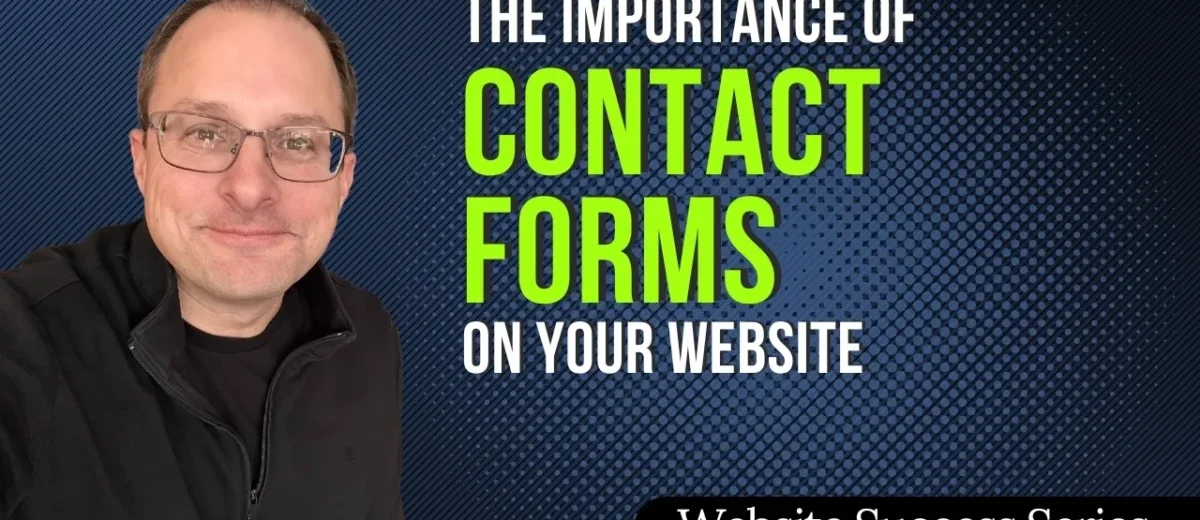The Importance of Contact Forms On Your Website
Have you ever filled out a website contact form and then… nothing? Complete silence?
I have, and it’s frustrating. No confirmation. No idea if my message went through. Just that uncomfortable feeling of wondering, “Did anyone actually get this?”
Now, think about your own website. Could this be happening to your potential customers? And if it is, how do you think that makes them feel?
The Truth About Contact Forms
Your contact form isn’t just a box on your website – it’s often the very first conversation someone tries to have with your business. And that first impression matters more than you might think.
Think about it this way: By the time someone reaches your contact form, they’ve already:
- Searched for solutions to their problem
- Found your website
- Decided you might be worth talking to
That’s a lot of momentum! But here’s where things often go wrong…
The Momentum Killers
I’ve reviewed hundreds of business websites, and I keep seeing the same issues that make people hesitate to reach out:
- The Black Hole Effect: When forms don’t tell people what happens next, it feels like sending a message into space. (Will anyone actually read this?)
- The One-Size-Fits-Nobody Form: Using a single generic “Contact Us” form for everything. (Who’s actually going to see this message?)
- The Trust Gap: Nothing that reassures visitors they’ll get a response (or won’t get spammed).
- The Information Overload: Forms that ask for way too much information upfront.
Let me share a real example that illustrates this perfectly…
An aircraft sales company had one generic form for all inquiries on their website. Since they had a global sales team, messages were going to the wrong people and slowing down responses. The fix? Instead of one form, they created a directory so visitors could reach the right person immediately. The result? Faster responses, better conversations, and more sales.
Making Your Contact Form Work For You (Not Against You)
Here’s what I’ve learned after helping countless businesses fix their contact forms: People just want to know three things when they reach out:
- Is a real human going to see this?
- Did my message go to the right place?
- When and how will I hear back?
That’s it! Not complicated, right? Yet so many businesses miss these basics.
One of my favorite examples is from a wilderness therapy organization I worked with. They were struggling to get parents to open up through their contact form. The fix was surprisingly simple – they added a photo and a short bio of their Admissions Director right next to the form, with a message explaining what happens after submission. Suddenly, parents started writing detailed, heartfelt messages because they felt like they were reaching out to a real person, not just submitting a form into the void.
The lesson? When people feel like their message matters, they give more information, making it easier to help them.
Should Your Business Use Multiple Contact Forms?
Sometimes one form isn’t enough. If you serve different customer needs, a single “Contact Us” form might actually be causing confusion instead of helping.
Here’s another real example: A baseball bat manufacturer had customers trying to file warranty claims through the same form that sales leads were using. This meant:
- Warranty requests were getting lost in a flood of unrelated messages
- Customers weren’t providing enough details, leading to frustrating back-and-forth
- The team was wasting time sorting through inquiries instead of resolving them quickly
The fix? They created a dedicated “Register Your Warranty” form that collected the right details from the start. Simple, but effective.
Making Your Business More Efficient
A well-structured contact form doesn’t just help your customers – it makes life easier for your team too:
- It reduces unnecessary emails by guiding people to provide the right details upfront
- It speeds up response times by getting inquiries to the right people
- It sets clear expectations so people don’t have to follow up multiple times
A Quick Self-Check for Your Contact Form
Take a moment right now and ask yourself:
- Does your form make it crystal clear what happens after someone hits “submit”?
- Would you feel confident filling out your own contact form?
- Does it feel like reaching out to a real person or dropping a message into a void?
Here’s What You Can Do Today
If you’re ready to turn your contact form from a potential roadblock into a trust-building tool, start with these simple fixes:
- Add a friendly message explaining exactly what happens after submission
- Include a photo and brief bio of who will receive the message
- Set clear expectations about response times
- Consider whether you need multiple forms for different types of inquiries
Remember: Every hesitation someone feels when reaching out is a potential conversation – and customer – lost.
Want to make this even more concrete? Send me your contact form and I’ll give you specific suggestions for improvement. Because at the end of the day, this isn’t just about forms – it’s about making it easier for people to start conversations with your business.
